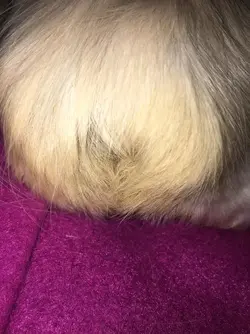Claire W
Forum Donator 2024/25
- Joined
- Mar 23, 2008
- Messages
- 37,324
- Reaction score
- 30,057
- Points
- 2,915
1 A Safe Full Bath - Step by Step
- When and how often should you bathe your guinea pigs?
- What items do you require for bathing your guinea pig?
- Recommended shampoos
- Getting started
- Bathing your guinea pig
- Drying your guinea pigs
2 Bum Baths (Partial Baths and Washes)
- What is a 'bum bath' and when should it be used?
- Caked on poos
- Bum hair care tips
- Boar care tips
- Care tips for older and less mobile guinea pigs (inc. urine scald and bumblefoot)
3 Cleaning the Grease Gland
1 A Safe Full Bath - Step by Step
When and how often should you bathe your guinea pigs?
Guinea pigs do not need regular and definitely not frequent baths; perhaps a couple of times a year at the most although some guinea pigs, especially boars, can be dirtier than others so may need bathing more often. Longer or rough-haired breeds may also need bathing more often but bathing too often can cause the skin to dry out and strip the coat of its natural oils.
For any medicated baths and dips please follow the advice on the bottle. A dip is a bath which needs the preparation drying onto skin without a rinse-off or with needing to wait for a specific amount of time to allow the dip to be absorbed into the skin.
In most cases a gentle quick ‘bum bath’ (see chapter 2) with baby-warm water is sufficient to keep soiled genitalia, paws and back ends clean. This especially for messy boars and guinea pigs with mobility issues that can no longer clean themselves and need daily cleaning.
In long-haired guinea pigs please keep any hairs around the genitalia, the legs and lower back cut short in order to minimise soiling and matting. Do a quick haircut before bathing if necessary. A haircut is also the only effective way to remove yellow urine stains from white coats; shampoos won't do the trick.
Please see the pictures and videos in our hair cutting guide for help: The Illustrated Guide to Hair Cutting
Please do NOT bathe any guinea pigs that are suffering from respiratory illnesses or undiagnosed skin problems before they have been seen by a vet.
When bathing your guinea pigs, please choose a warm day especially for outdoor guinea pigs unless you are bathing for a medical reason such as fungal or parasitic issues. Do not put any outdoors guinea pigs back unless their coats are fully dried. Make sure that your bathroom and the guinea pig room is heated while your guinea pigs are being bathed and are drying.
Swimming and deep baths are a big NO for guinea pigs.
Can And Should Guinea Pigs Swim?
What items do you require for bathing your guinea pig?
• A clean empty bathtub or shower floor
• A clean washing up bowl
• Clean dry towels
• A jug or shower head
• Small animal friendly shampoo or special medicated shampoo or dip
• Disposable gloved (a must if your guinea pig has transmittable ringworm)
• Hairdryer (optional) or microwaveable snugglesafepads (optional)
Recommended shampoos
Please note that we do not recommend treating any skin problems on spec without a vet diagnosis.
The following places offer specially formulated organic shampoos for guinea pigs that are free of any noxious ingredients and suitable for a guinea pig skin ph:
UK with worldwide shipping: Gorgeous Guineas - Aromatherapy skincare products for guinea pigs
US wide shipping: Wee Companions Small Animal Adoption, Inc. - Animal Accessories
If you can't get hold of either, a mild baby shampoo will do as long as you do not use it very frequently, in which case it can cause skin problems in the longer term (dry skin, cracks through which bugs cn get into).
For any medicated shampoos please see your vet for an assessment.
Medical products are listed in our Ringworm Guide: Ringworm: Hygiene, Care And Pictures
Getting started
It is advisable to have the bathing area set up and ready to bathe your guinea pig before you bring them in to avoid unnecessary stress. It is safest to use a washing up bowl filled with just enough warm water to cover the guinea pigs legs that just touches their belly (roughly 2inches / 5 cm) and placed inside the bathtub or shower to avoid any nasty accidents should your guinea pig decide to jump.
Place a dry towel inside the bathtub or shower and on the bottom of the bowl if you wish to prevent your guinea pig from slipping.
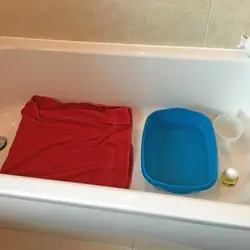
Please do NOT use a kitchen or bathroom sink. The risk of severe injuries from blind jumps by a panicked guinea pig is too great. The floor of a bathtub or shower with a towel for grip allows safe jumps but as it is a confined area, will prevent your guinea pigs from running away and hiding in a cranny. It can also be easily cleaned afterwards.
Bathing your guinea pigs
Fill the bowl with 1-2 inches of baby warm water (test with your elbow). The water should not touch the belly of a guinea pig at this stage.
Gently place your guinea pig in to the bowl of water keeping your hands close to the guinea pig. If your guinea pig is a jumper, it is advisable to face the guinea pig away from you to prevent it from jumping in to your arms although some guinea pigs prefer to be able to see you so see what your guinea pig prefers. Place a firm grip on the back of your guinea pig but do not apply too much pressure.
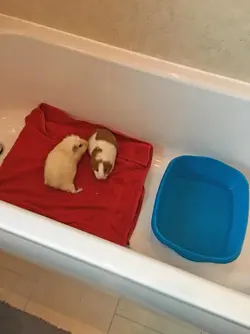
Wet the guinea pig all over, using your hands, a jug or the shower head and taking care not to pour any water directly on the head, face, eyes or ears.
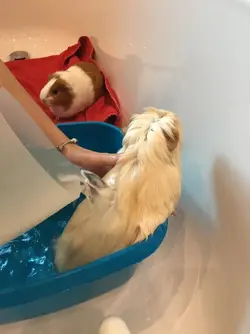
Squeeze a strip of shampoo along the guinea pig’s spineor into your hand, gently lathering the guinea pigs fur again avoiding the face, eyes and ears.
Leave the face and ears be, and only ever use lather and soft moist rag anywhere near the face or ears. The active ingredient in medicated shampoos or dips will be spread onto the head by the piggy cleaning itself during the recommended wait.
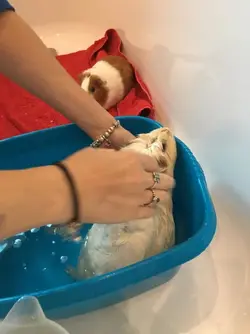
Gently but with a firm hold lift your guinea pig out.
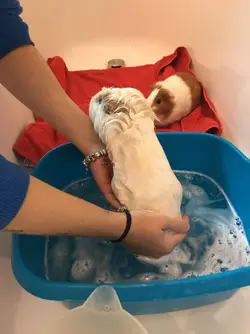
Place the guinea pig on the towel in the bathtub or shower while you refill the washing-up bowl with freshwater unless you prefer to have two washing up bowls of water on the go.
Leave any shampoo or medicated dip to work in for the recommended time. Dips are usually left to dry without rinsing.
In the meantime repeat the process with any companions.

Once all piggies shampooed, place the first guinea pig bac in to the rinsed and freshly refilled bowl and rinse carefully with clean and baby warm water as before, using your hands, jug or showerhead but avoiding splashing any water on the head and ears. Always check the water temperature!
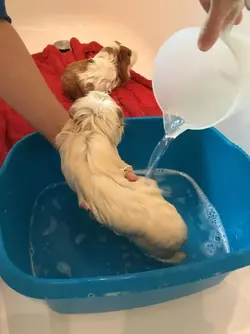
Remove your guinea pig from the water and wrap in a dry towel to dry.
Use a moist but not dripping clean rag to gently remove any lather from the face if any has got onto it.
Drying your guinea pigs
Allow the guinea pigs to rest for a couple of minutes whilst being wrapped in the towel and allow the towel to absorb as much of the water as possible. Then transfer your guinea pig to a new dry towel and gently massage the fur until no more water can be absorbed and until the guinea pig feels damp, but not soaking.

A hairdryer on the lowest setting and from at least a foot distance can be used to fully dry the guinea pig (if the guinea pig allows it) but if not, the guinea pig is nowable to be put back in to their clean cage or play pen to groom themselves and dry off fully. If your house is relatively cool, use a half-heated snugglesafe and make a fleece nest in your carrier to allow your guinea pigs to dry off warmly. A shivering guinea pig is a cold guinea pig!
Please do NOT put guinea pigs outside / in to their outdoor hutch until they are completely dry.
- When and how often should you bathe your guinea pigs?
- What items do you require for bathing your guinea pig?
- Recommended shampoos
- Getting started
- Bathing your guinea pig
- Drying your guinea pigs
2 Bum Baths (Partial Baths and Washes)
- What is a 'bum bath' and when should it be used?
- Caked on poos
- Bum hair care tips
- Boar care tips
- Care tips for older and less mobile guinea pigs (inc. urine scald and bumblefoot)
3 Cleaning the Grease Gland
1 A Safe Full Bath - Step by Step
When and how often should you bathe your guinea pigs?
Guinea pigs do not need regular and definitely not frequent baths; perhaps a couple of times a year at the most although some guinea pigs, especially boars, can be dirtier than others so may need bathing more often. Longer or rough-haired breeds may also need bathing more often but bathing too often can cause the skin to dry out and strip the coat of its natural oils.
For any medicated baths and dips please follow the advice on the bottle. A dip is a bath which needs the preparation drying onto skin without a rinse-off or with needing to wait for a specific amount of time to allow the dip to be absorbed into the skin.
In most cases a gentle quick ‘bum bath’ (see chapter 2) with baby-warm water is sufficient to keep soiled genitalia, paws and back ends clean. This especially for messy boars and guinea pigs with mobility issues that can no longer clean themselves and need daily cleaning.
In long-haired guinea pigs please keep any hairs around the genitalia, the legs and lower back cut short in order to minimise soiling and matting. Do a quick haircut before bathing if necessary. A haircut is also the only effective way to remove yellow urine stains from white coats; shampoos won't do the trick.
Please see the pictures and videos in our hair cutting guide for help: The Illustrated Guide to Hair Cutting
Please do NOT bathe any guinea pigs that are suffering from respiratory illnesses or undiagnosed skin problems before they have been seen by a vet.
When bathing your guinea pigs, please choose a warm day especially for outdoor guinea pigs unless you are bathing for a medical reason such as fungal or parasitic issues. Do not put any outdoors guinea pigs back unless their coats are fully dried. Make sure that your bathroom and the guinea pig room is heated while your guinea pigs are being bathed and are drying.
Swimming and deep baths are a big NO for guinea pigs.
Can And Should Guinea Pigs Swim?
What items do you require for bathing your guinea pig?
• A clean empty bathtub or shower floor
• A clean washing up bowl
• Clean dry towels
• A jug or shower head
• Small animal friendly shampoo or special medicated shampoo or dip
• Disposable gloved (a must if your guinea pig has transmittable ringworm)
• Hairdryer (optional) or microwaveable snugglesafepads (optional)
Recommended shampoos
Please note that we do not recommend treating any skin problems on spec without a vet diagnosis.
The following places offer specially formulated organic shampoos for guinea pigs that are free of any noxious ingredients and suitable for a guinea pig skin ph:
UK with worldwide shipping: Gorgeous Guineas - Aromatherapy skincare products for guinea pigs
US wide shipping: Wee Companions Small Animal Adoption, Inc. - Animal Accessories
If you can't get hold of either, a mild baby shampoo will do as long as you do not use it very frequently, in which case it can cause skin problems in the longer term (dry skin, cracks through which bugs cn get into).
For any medicated shampoos please see your vet for an assessment.
Medical products are listed in our Ringworm Guide: Ringworm: Hygiene, Care And Pictures
Getting started
It is advisable to have the bathing area set up and ready to bathe your guinea pig before you bring them in to avoid unnecessary stress. It is safest to use a washing up bowl filled with just enough warm water to cover the guinea pigs legs that just touches their belly (roughly 2inches / 5 cm) and placed inside the bathtub or shower to avoid any nasty accidents should your guinea pig decide to jump.
Place a dry towel inside the bathtub or shower and on the bottom of the bowl if you wish to prevent your guinea pig from slipping.

Please do NOT use a kitchen or bathroom sink. The risk of severe injuries from blind jumps by a panicked guinea pig is too great. The floor of a bathtub or shower with a towel for grip allows safe jumps but as it is a confined area, will prevent your guinea pigs from running away and hiding in a cranny. It can also be easily cleaned afterwards.
Bathing your guinea pigs
Fill the bowl with 1-2 inches of baby warm water (test with your elbow). The water should not touch the belly of a guinea pig at this stage.
Gently place your guinea pig in to the bowl of water keeping your hands close to the guinea pig. If your guinea pig is a jumper, it is advisable to face the guinea pig away from you to prevent it from jumping in to your arms although some guinea pigs prefer to be able to see you so see what your guinea pig prefers. Place a firm grip on the back of your guinea pig but do not apply too much pressure.

Wet the guinea pig all over, using your hands, a jug or the shower head and taking care not to pour any water directly on the head, face, eyes or ears.

Squeeze a strip of shampoo along the guinea pig’s spineor into your hand, gently lathering the guinea pigs fur again avoiding the face, eyes and ears.
Leave the face and ears be, and only ever use lather and soft moist rag anywhere near the face or ears. The active ingredient in medicated shampoos or dips will be spread onto the head by the piggy cleaning itself during the recommended wait.

Gently but with a firm hold lift your guinea pig out.

Place the guinea pig on the towel in the bathtub or shower while you refill the washing-up bowl with freshwater unless you prefer to have two washing up bowls of water on the go.
Leave any shampoo or medicated dip to work in for the recommended time. Dips are usually left to dry without rinsing.
In the meantime repeat the process with any companions.

Once all piggies shampooed, place the first guinea pig bac in to the rinsed and freshly refilled bowl and rinse carefully with clean and baby warm water as before, using your hands, jug or showerhead but avoiding splashing any water on the head and ears. Always check the water temperature!

Remove your guinea pig from the water and wrap in a dry towel to dry.
Use a moist but not dripping clean rag to gently remove any lather from the face if any has got onto it.
Drying your guinea pigs
Allow the guinea pigs to rest for a couple of minutes whilst being wrapped in the towel and allow the towel to absorb as much of the water as possible. Then transfer your guinea pig to a new dry towel and gently massage the fur until no more water can be absorbed and until the guinea pig feels damp, but not soaking.

A hairdryer on the lowest setting and from at least a foot distance can be used to fully dry the guinea pig (if the guinea pig allows it) but if not, the guinea pig is nowable to be put back in to their clean cage or play pen to groom themselves and dry off fully. If your house is relatively cool, use a half-heated snugglesafe and make a fleece nest in your carrier to allow your guinea pigs to dry off warmly. A shivering guinea pig is a cold guinea pig!
Please do NOT put guinea pigs outside / in to their outdoor hutch until they are completely dry.
